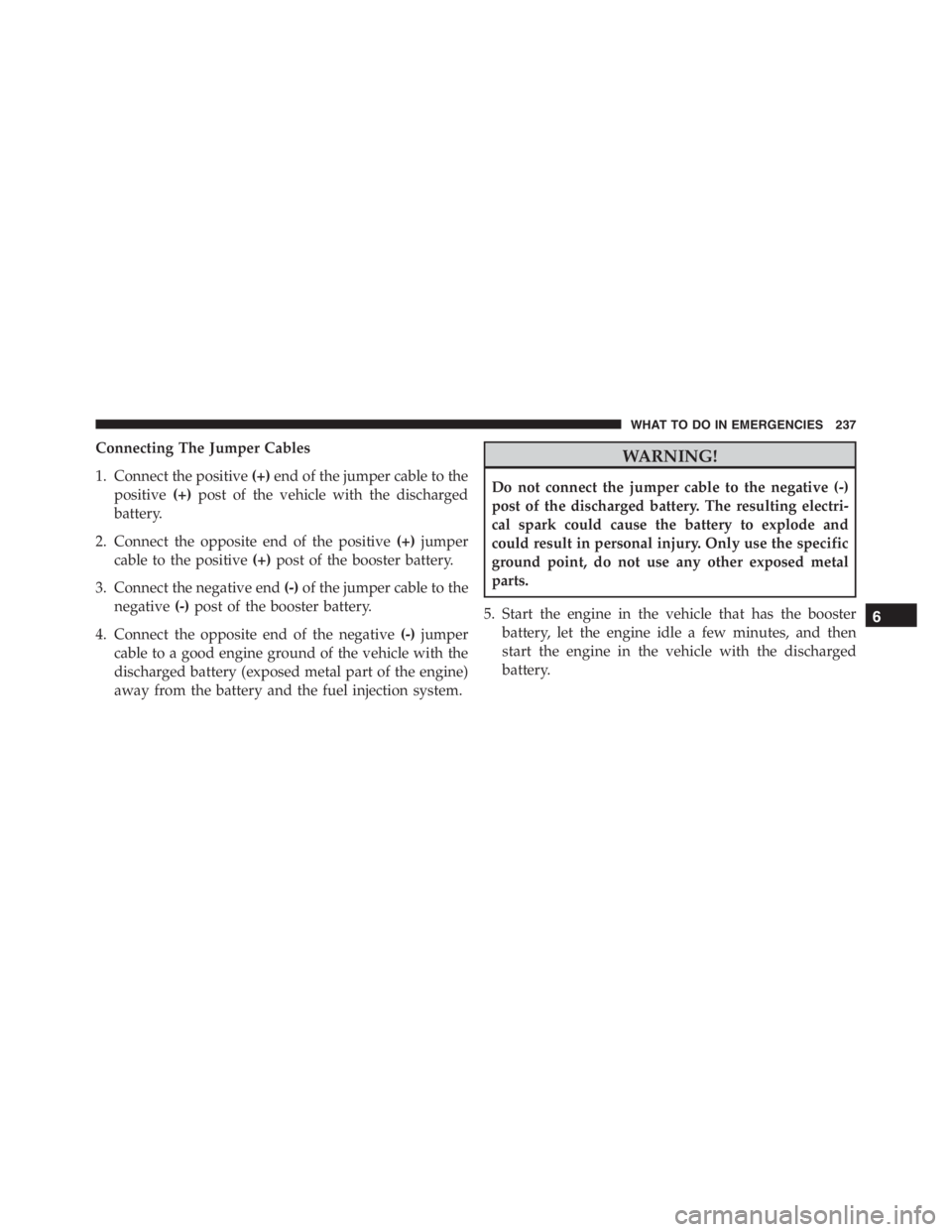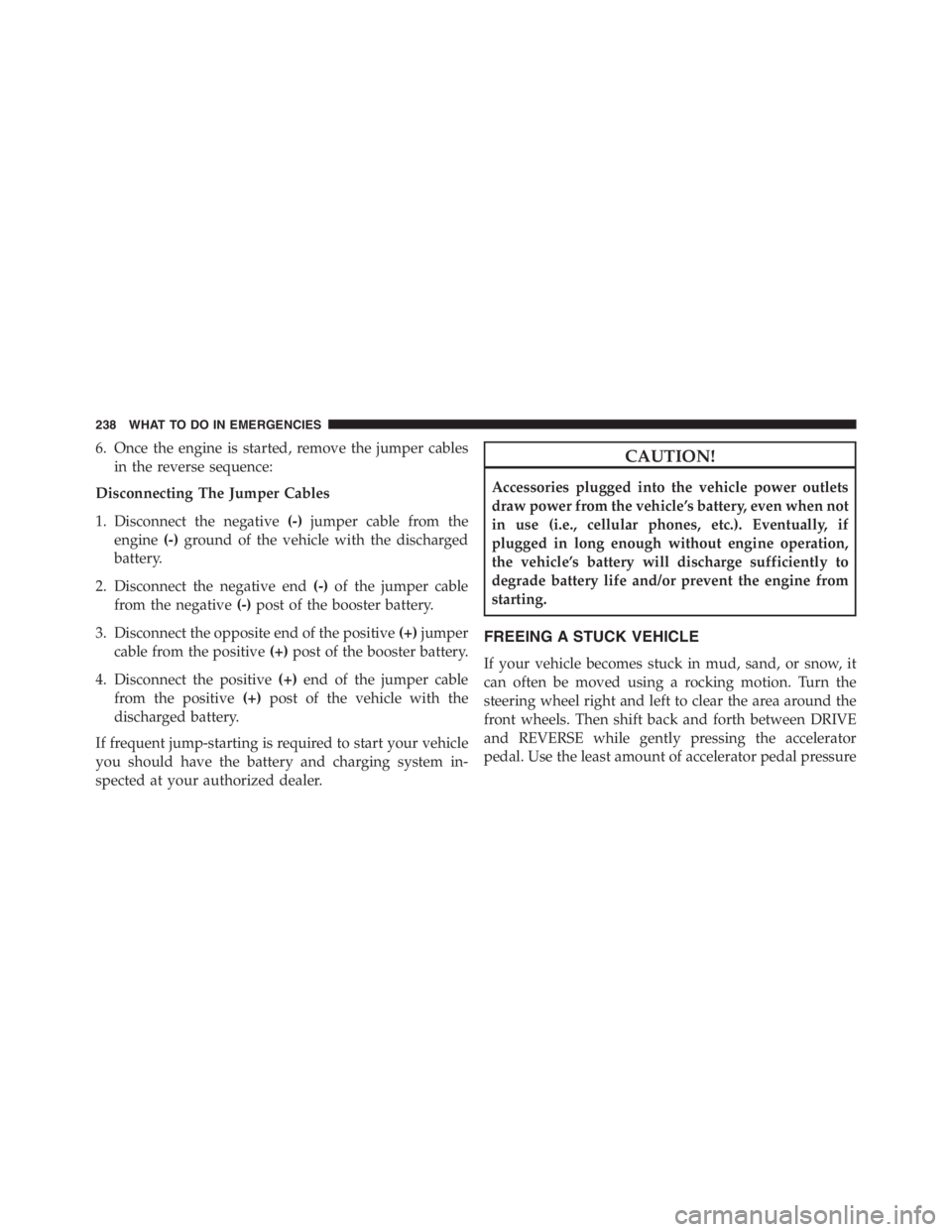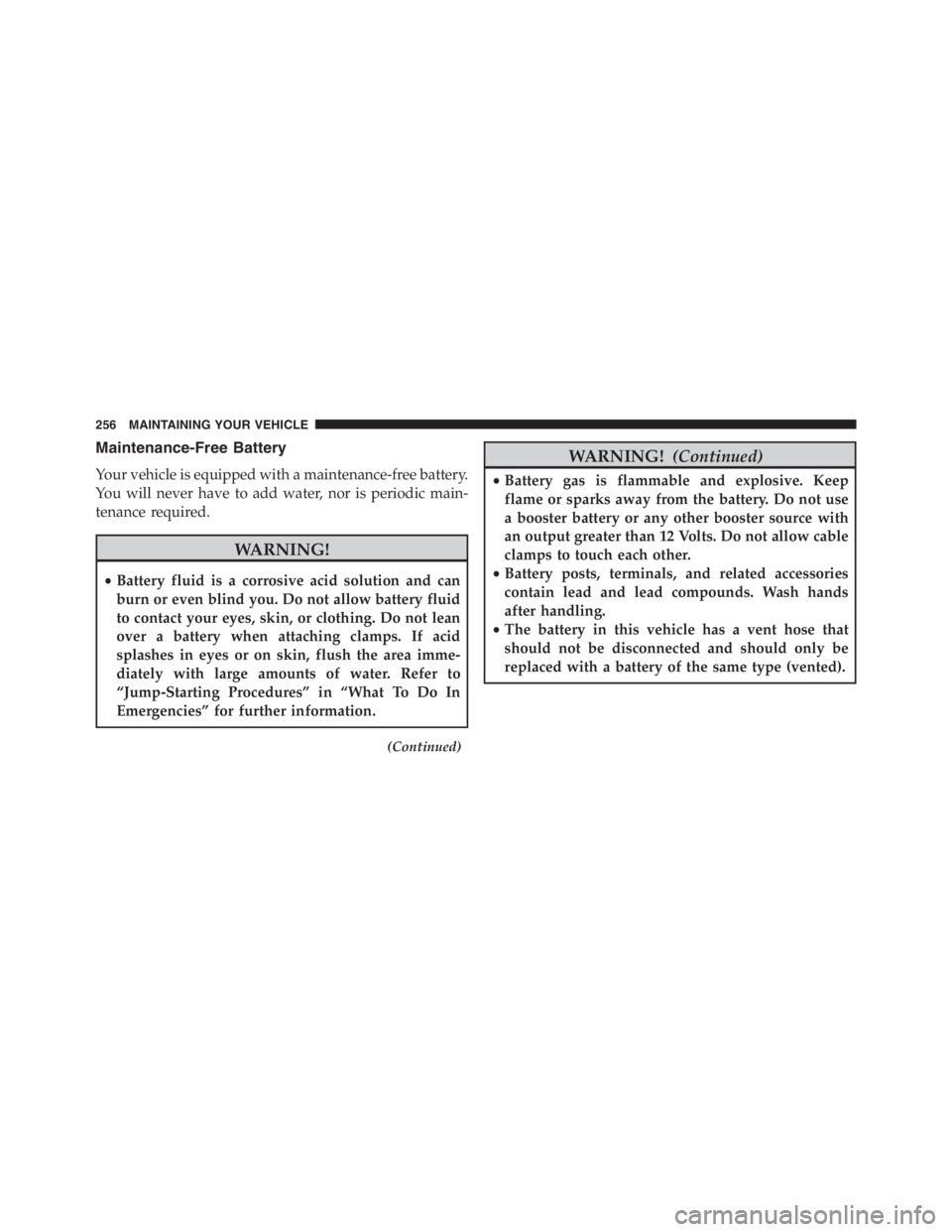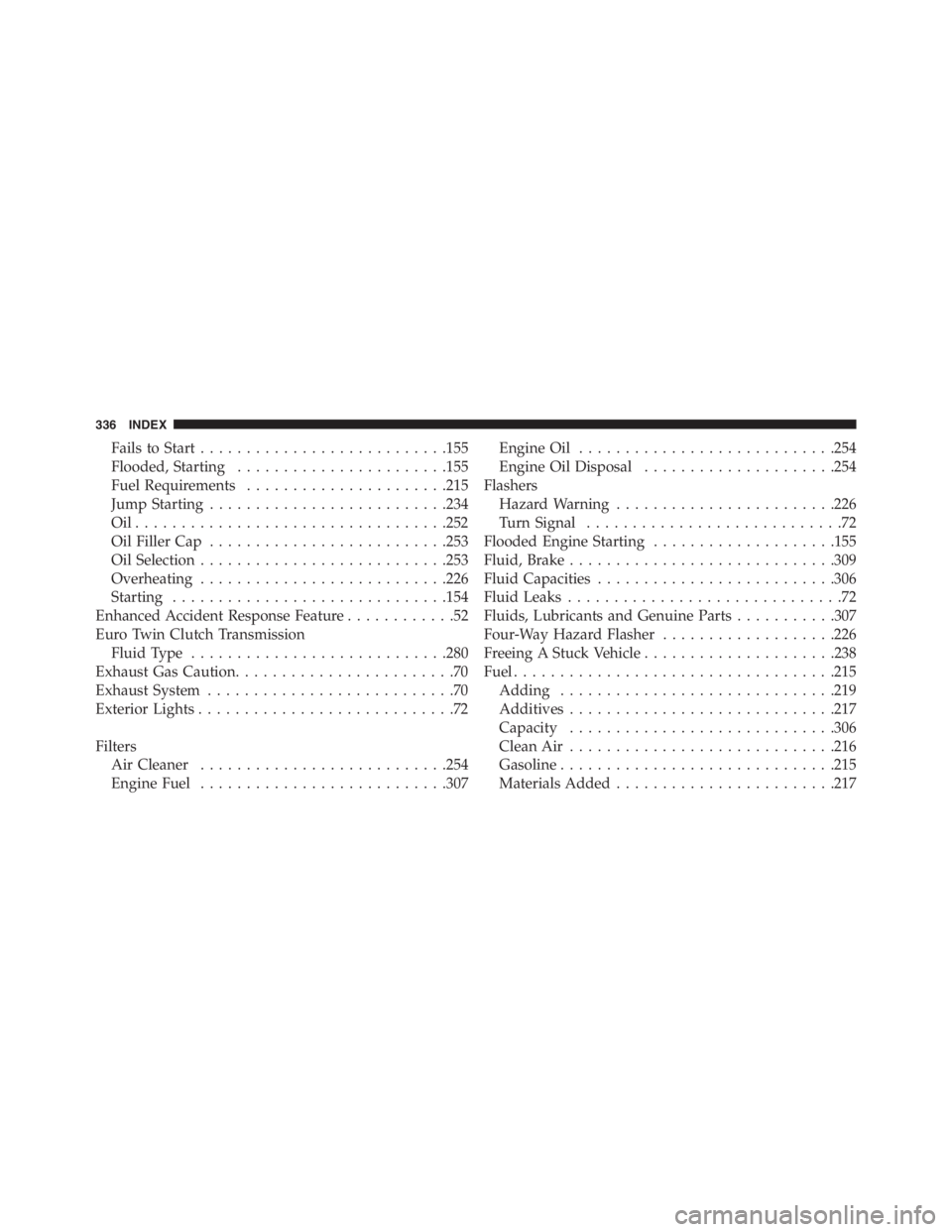Page 227 of 348
WHAT TO DO IN EMERGENCIES
CONTENTS
�HAZARD WARNING FLASHER...........226
�IF YOUR ENGINE OVERHEATS............226
�WHEEL AND TIRE TORQUE
SPECIFICATIONS......................227
▫Torque Specifications...................228
�TIRE SERVICE KIT......................230
�JUMP-STARTING......................234
▫Preparations For Jump-Start..............234▫Jump-Starting Procedure................236
�FREEING A STUCK VEHICLE.............238
�
ENHANCED ACCIDENT RESPONSE SYSTEM . .240
�FRONT TOW EYE USAGE................242
�FIRE EXTINGUISHER — IF EQUIPPED.......2456
Page 236 of 348

WARNING!
Store the sealant canister in its special compartment,
away from sources of heat.
JUMP-STARTING
If your vehicle has a discharged battery it can be jump-
started using a set of jumper cables and a battery in
another vehicle or by using a portable battery booster
pack. Jump-starting can be dangerous if done improperly
so please follow the procedures in this section carefully.
NOTE:When using a portable battery booster pack
follow the manufacturer’s operating instructions and
precautions.
CAUTION!
Do not use a portable battery booster pack or any
other booster source with a system voltage greater
than 12 Volts or damage to the battery, starter motor,
alternator or electrical system may occur.
WARNING!
Do not attempt jump-starting if the battery is frozen.
It could rupture or explode and cause personal injury.
Preparations For Jump-Start
The battery in your vehicle is located on the left side of
the engine compartment. To access the battery remove
the protective cover.
234 WHAT TO DO IN EMERGENCIES
Page 238 of 348
4. If using another vehicle to jump-start the battery, park
the vehicle within the jumper cables reach, set the
parking brake and make sure the ignition is OFF.
WARNING!
Do not allow vehicles to touch each other as this
could establish a ground connection and personal
injury could result.
Jump-Starting Procedure
WARNING!
Failure to follow this jump-starting procedure could
result in personal injury or property damage due to
battery explosion.
CAUTION!
Failure to follow these procedures could result in
damage to the charging system of the booster vehicle
or the discharged vehicle.
Positive (+) Battery Post
236 WHAT TO DO IN EMERGENCIES
Page 239 of 348

Connecting The Jumper Cables
1. Connect the positive(+)end of the jumper cable to the
positive(+)post of the vehicle with the discharged
battery.
2. Connect the opposite end of the positive(+)jumper
cable to the positive(+)post of the booster battery.
3. Connect the negative end(-)of the jumper cable to the
negative(-)post of the booster battery.
4. Connect the opposite end of the negative(-)jumper
cable to a good engine ground of the vehicle with the
discharged battery (exposed metal part of the engine)
away from the battery and the fuel injection system.WARNING!
Do not connect the jumper cable to the negative (-)
post of the discharged battery. The resulting electri-
cal spark could cause the battery to explode and
could result in personal injury. Only use the specific
ground point, do not use any other exposed metal
parts.
5. Start the engine in the vehicle that has the booster
battery, let the engine idle a few minutes, and then
start the engine in the vehicle with the discharged
battery.
6
WHAT TO DO IN EMERGENCIES 237
Page 240 of 348

6. Once the engine is started, remove the jumper cables
in the reverse sequence:
Disconnecting The Jumper Cables
1. Disconnect the negative(-)jumper cable from the
engine(-)ground of the vehicle with the discharged
battery.
2. Disconnect the negative end(-)of the jumper cable
from the negative(-)post of the booster battery.
3. Disconnect the opposite end of the positive(+)jumper
cable from the positive(+)post of the booster battery.
4. Disconnect the positive(+)end of the jumper cable
from the positive(+)post of the vehicle with the
discharged battery.
If frequent jump-starting is required to start your vehicle
you should have the battery and charging system in-
spected at your authorized dealer.CAUTION!
Accessories plugged into the vehicle power outlets
draw power from the vehicle’s battery, even when not
in use (i.e., cellular phones, etc.). Eventually, if
plugged in long enough without engine operation,
the vehicle’s battery will discharge sufficiently to
degrade battery life and/or prevent the engine from
starting.
FREEING A STUCK VEHICLE
If your vehicle becomes stuck in mud, sand, or snow, it
can often be moved using a rocking motion. Turn the
steering wheel right and left to clear the area around the
front wheels. Then shift back and forth between DRIVE
and REVERSE while gently pressing the accelerator
pedal. Use the least amount of accelerator pedal pressure
238 WHAT TO DO IN EMERGENCIES
Page 258 of 348

Maintenance-Free Battery
Your vehicle is equipped with a maintenance-free battery.
You will never have to add water, nor is periodic main-
tenance required.
WARNING!
•Battery fluid is a corrosive acid solution and can
burn or even blind you. Do not allow battery fluid
to contact your eyes, skin, or clothing. Do not lean
over a battery when attaching clamps. If acid
splashes in eyes or on skin, flush the area imme-
diately with large amounts of water. Refer to
“Jump-Starting Procedures” in “What To Do In
Emergencies” for further information.
(Continued)
WARNING!(Continued)
•Battery gas is flammable and explosive. Keep
flame or sparks away from the battery. Do not use
a booster battery or any other booster source with
an output greater than 12 Volts. Do not allow cable
clamps to touch each other.
•Battery posts, terminals, and related accessories
contain lead and lead compounds. Wash hands
after handling.
•The battery in this vehicle has a vent hose that
should not be disconnected and should only be
replaced with a battery of the same type (vented).
256 MAINTAINING YOUR VEHICLE
Page 337 of 348

Change Engine Oil......................137
Change Engine Oil Indicator System..........137
Daytime Running Lamps (DRL).............136
Distance Traveled.......................141
Electronic Vehicle Information Center (EVIC). . . .125
Electronic Vehicle Information Center (EVIC) Setup
Menu................................127
Exit Menu............................137
Exit Trip..............................139
Fuel Range............................140
Indications On Display...................140
Instant Fuel Consumption.................141
Language (Selecting The Language)..........134
NewTrip .............................139
Oil Life..............................137
Service (Scheduled Servicing)...............135
Set Date..............................131
Speed Beep (Speed Limit).................128
Start Of Trip Procedure...................139Time Adjustment (Clock)..................130
Travel Time...........................141
Trip Button............................137
Trip Computer.........................137
Trip Functions.........................138
Units (Set Units)........................133
Values Displayed.......................140
Emergency, In Case of
Freeing Vehicle When Stuck................238
Hazard Warning Flasher..................226
Jump Starting..........................234
Overheating...........................226
Engine
Air Cleaner...........................254
Break-In Recommendations.................68
Checking Oil Level......................252
Compartment..........................249
Cooling..............................268
Exhaust Gas Caution.....................70
10
INDEX 335
Page 338 of 348

Fails to Start...........................155
Flooded, Starting.......................155
Fuel Requirements......................215
Jump Starting..........................234
Oil..................................252
Oil Filler Cap..........................253
Oil Selection...........................253
Overheating...........................226
Starting..............................154
Enhanced Accident Response Feature............52
Euro Twin Clutch Transmission
Fluid Type............................280
Exhaust Gas Caution........................70
Exhaust System...........................70
Exterior Lights............................72
Filters
Air Cleaner...........................254
Engine Fuel...........................307Engine Oil............................254
Engine Oil Disposal.....................254
Flashers
Hazard Warning........................226
Turn Signal............................72
Flooded Engine Starting....................155
Fluid, Brake.............................309
Fluid Capacities..........................306
Fluid Leaks..............................72
Fluids, Lubricants and Genuine Parts...........307
Four-Way Hazard Flasher...................226
Freeing A Stuck Vehicle.....................238
Fuel...................................215
Adding..............................219
Additives.............................217
Capacity.............................306
Clean Air.............................216
Gasoline..............................215
Materials Added........................217
336 INDEX